 Re: CA/OR/WA 04/09–04/25, 2010 - 59 LHs, 2 LShips, 9 Fresnels, 2 Faux LHs, 4 Canadian LHs
#68583
06/20/10 07:52 PM Re: CA/OR/WA 04/09–04/25, 2010 - 59 LHs, 2 LShips, 9 Fresnels, 2 Faux LHs, 4 Canadian LHs
#68583
06/20/10 07:52 PM
|
Joined: Dec 2002
Posts: 1,964
sandy
 OP
OP
Cruise Director
|
OP

Cruise Director
Joined: Dec 2002
Posts: 1,964 |
If memory serves, we were able to get photographs of Lime Point located at the north end of the Golden Gate Bridge from Fort Point located at the south end of that famous bridge: 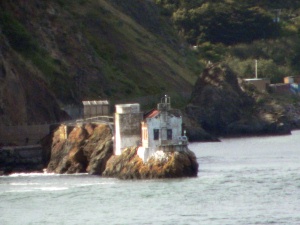 The San Francisco Bay is the only gap in the Coastal Range mountains between Cape Mendocino and Point Sur that the Pacific fog can enter and the bay is frequently engulfed in fog. A fog signal station was built at the Lime Point site in 1883 and used a pair of 12" steam whistles that were fueled by water from a 20,000 gallon tank that was filled with water obtained from a nearby spring. The fog station received a small 300 mm lens lantern in 1900. When the Golden Gate Bridge was completed in 1937, the Fort Point Light was extinguished. Lime Point continued service, but keepers now had to deal with items being dropped by visitors on the bridge that could cause serious injury, as well as the orange tinge on the station’s buildings and laundry from the orange paint used on the bridge. Automated in 1961, all structures were removed from the site except the fog signal building shown in the picture. Vandals and neglect make for a very desolate picture. Our final stop of the day was Point Bonita Light, located at the northern entrance to the San Francisco Bay: 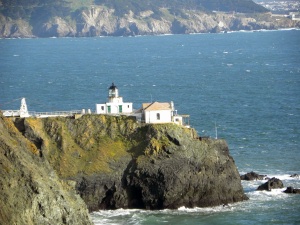 Its original name was “Point Boneta”–a reference to the resemblance of the area hills to the hats worn by Spanish religious officials. The first lighthouse was a California-cottage style dwelling with a separate tower that was situated on the highest hill in the area–260' above sea level. The 56' high tower housed a fixed 2nd-Order Fresnel lens (the most powerful beacon of the San Francisco Bay) that was lit for the first time in May of 1855. Fog was a major problem and the lighthouse was often obscured by high fog. That problem eventually led to moving the light from the top of the hill to the far end of the point, an area called Land’s End. The new lighthouse was completed in 1877. The black lantern room and lens from the original tower were used and the original tower was capped. The new building was a 1-story building with 3 rooms. The central room was built with heavy walls to support the tower; the entire structure was 33' high. Both the original tower (serving as a useful daymark) and the replacement lighthouse survived the 1906 San Francisco Earthquake, but the original tower was removed by the Army in 1907. The Coast Guard closed the station to the public in the 1960s. Point Bonita was the last manned lighthouse in California and was automated in 1979. Its original 2nd-Order Fresnel lens is still in the tower. The Coast Guard maintains the light, but the station is maintained by the National Parks Service as part of the Golden Gate National Recreational Area. Sunday, April 18th: 280 miles, 3 lighthouses: 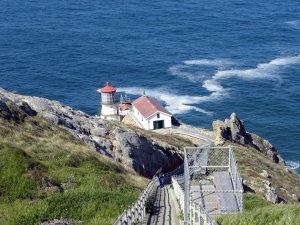 One of the foggiest and windiest stations in the U.S., the original plan for Point Reyes Lighthouse was a 2-story dwelling with an integral tower, much like those built at Point Pinos and Old Point Loma, locating the light on top of the bluff at Point Reyes. However, knowing from Point Bonita that fog could obscure an elevated light, the plan was changed to place the light 275' lower on the bluff. Two terraces were carved out of the cliffs, one at 100' above sea level for the fog signal building and a second one 150' high for the light tower. A 300-step wooden stairway was built into the cliff to reach the tower from the top of the bluff, and 338 more steps were required to reach the fog building. The lighthouse is a 16-sided, 37', iron tower, a twin of Cape Mendocino, anchored to the cliff with large bolts. It still shelters the 1st-Order Fresnel lens that was first lit on December 1, 1870. The lens has 24 bull’s-eye panels held in place by a brass frame. A 2-story, spacious dwelling was built for the keepers on top of the bluff where the present park service housing is located. 40 mph winds are common, with gusts as high as 133 mph. It is not unusual to have over 2,100 hours of fog annually. Major renovation work was done at the station is 2003, including repair of the existing buildings and replacing the 300+ steps leading to the tower. Next stop was Point Arena Lighthouse: 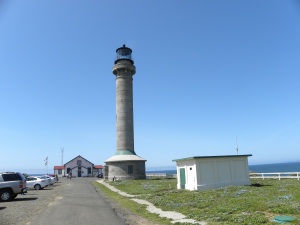 The coastline changes from running in a northwesterly direction to more of a northerly direction. Ships carrying redwood lumber from Northern California to San Francisco increased in the 1850s and 1860s and the need for a light to mark this critical turning point became very evident. The first Point Arena Lighthouse began service on May 1, 1870. Brick was the material chosen to construct the 10' tower, it had a 1st-Order Fresnel, and a large 2-1/2-story, brick dwelling was near the base of the tower to house four keepers and their families. The San Andreas Fault is just offshore from the point, but the lighthouse survived many earthquakes during its 36 years of service. However, the 1906 San Francisco Earthquake damaged both the tower and the dwelling beyond repair and they had to be razed. All the brick and other material that could not be used in reconstructing the station were simply pushed over the cliff into the ocean. A temporary short wooden light tower was built initially and the lantern room from the original lighthouse was placed on top of it. Outfitted with a 2nd-Order lens, that tower began operation in January of 1907. Reinforced concrete was used for the new tower which was built on the site of the original tower. Iron bars were woven together, surrounded by wooden frames, and covered by concrete to create the tower. This new 115' tower had a 1st-Order Fresnel lens that commenced operation on September 15, 1908. The station was automated in 1977 when a rotating beacon was placed on the tower’s balcony. 2008 renovations included work on th public restrooms, fog signal building, and tower, a new copper roof for the lantern room, and relocating of the 1st-Order Fresnel lens with its pedestal and drive mechanism to the fog signal/gift shop building. The tower remains unpainted due to a lack of funds, but a metal floor has been installed in the lantern room. Emptied of its Fresnel lens, the lantern room makes for a great observation room. 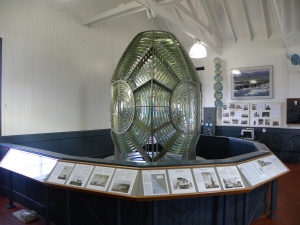 Point Arena 1st-Order Fresnel lens Our last stop for the day was Point Cabrillo Lighthouse: 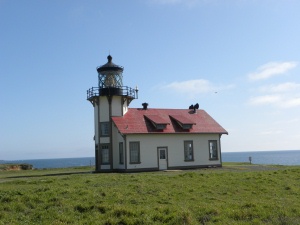 This combination lighthouse and fog signal building resembles a small church with a 47' octagonal tower attached to the eastern end of the small 1-1/2-story fog signal building. Two 18hp engines housed in the building ran an air compressor that powered twin sirens protruding from the western end of the roof. A 3rd-Order Fresnel lens using an oil lamp was lit for the first time in June of 1909, its characteristic of a white flash every 10 seconds by using a weight suspended in the tower. An upgrade to an oil-vapor lamp in 1911 was the light source until electricity reached the station in 1935, which allowed the use of an electric bulb to light the lens, as well as electric motors to both rotate the lens and power the fog signal. The last civilian keeper on the west coast retired from Point Cabrillo in February of 1963, having served there since 1952. The Coast Guard manned the station until the 1970s when the lens was covered and a modern rotating beacon was mounted on a metal stand on the roof just west of the lantern room. The California State Coastal Conservancy purchased the station in 1991 and partnered with the North Coast Interpretive Association, a non-profit group, to manage the preserve. A major restoration of the station was undertaken in 1996 and was completed over the next couple of years. In 2002, California State Parks purchased the station. Point Cabrillo Lightkeepers Association, a non-profit entity formed to continue the restoration of the facilities and protection of the surrounding wildlife habitat, carries on with the restoration work.
|
|
|
|
Entire Thread
|

 CA/OR/WA 04/09–04/25, 2010 - 59 LHs, 2 LShips, 9 Fresnels, 2 Faux LHs, 4 Canadian LHs
CA/OR/WA 04/09–04/25, 2010 - 59 LHs, 2 LShips, 9 Fresnels, 2 Faux LHs, 4 Canadian LHs
|
sandy
|
06/20/10 11:39 PM
|

 Re: CA/OR/WA 04/09–04/25, 2010 - 59 LHs, 2 LShips, 9 Fresnels, 2 Faux LHs, 4 Canadian LHs
Re: CA/OR/WA 04/09–04/25, 2010 - 59 LHs, 2 LShips, 9 Fresnels, 2 Faux LHs, 4 Canadian LHs
|
sandy
|
06/20/10 11:39 PM
|

 Re: CA/OR/WA 04/09–04/25, 2010 - 59 LHs, 2 LShips, 9 Fresnels, 2 Faux LHs, 4 Canadian LHs
Re: CA/OR/WA 04/09–04/25, 2010 - 59 LHs, 2 LShips, 9 Fresnels, 2 Faux LHs, 4 Canadian LHs
|
sandy
|
06/20/10 11:40 PM
|

 Re: CA/OR/WA 04/09–04/25, 2010 - 59 LHs, 2 LShips, 9 Fresnels, 2 Faux LHs, 4 Canadian LHs
Re: CA/OR/WA 04/09–04/25, 2010 - 59 LHs, 2 LShips, 9 Fresnels, 2 Faux LHs, 4 Canadian LHs
|
sandy
|
06/20/10 11:40 PM
|

 Re: CA/OR/WA 04/09–04/25, 2010 - 59 LHs, 2 LShips, 9 Fresnels, 2 Faux LHs, 4 Canadian LHs
Re: CA/OR/WA 04/09–04/25, 2010 - 59 LHs, 2 LShips, 9 Fresnels, 2 Faux LHs, 4 Canadian LHs
|
sandy
|
06/20/10 11:40 PM
|

 Re: CA/OR/WA 04/09–04/25, 2010 - 59 LHs, 2 LShips, 9 Fresnels, 2 Faux LHs, 4 Canadian LHs
Re: CA/OR/WA 04/09–04/25, 2010 - 59 LHs, 2 LShips, 9 Fresnels, 2 Faux LHs, 4 Canadian LHs
|
sandy
|
06/20/10 11:52 PM
|

 Re: CA/OR/WA 04/09–04/25, 2010 - 59 LHs, 2 LShips, 9 Fresnels, 2 Faux LHs, 4 Canadian LHs
Re: CA/OR/WA 04/09–04/25, 2010 - 59 LHs, 2 LShips, 9 Fresnels, 2 Faux LHs, 4 Canadian LHs
|
sandy
|
06/20/10 11:52 PM
|

 Re: CA/OR/WA 04/09–04/25, 2010 - 59 LHs, 2 LShips, 9 Fresnels, 2 Faux LHs, 4 Canadian LHs
Re: CA/OR/WA 04/09–04/25, 2010 - 59 LHs, 2 LShips, 9 Fresnels, 2 Faux LHs, 4 Canadian LHs
|
sandy
|
06/20/10 11:52 PM
|

 Re: CA/OR/WA 04/09–04/25, 2010 - 59 LHs, 2 LShips, 9 Fresnels, 2 Faux LHs, 4 Canadian LHs
Re: CA/OR/WA 04/09–04/25, 2010 - 59 LHs, 2 LShips, 9 Fresnels, 2 Faux LHs, 4 Canadian LHs
|
sandy
|
06/21/10 12:07 AM
|

 Re: CA/OR/WA 04/09–04/25, 2010 - 59 LHs, 2 LShips, 9 Fresnels, 2 Faux LHs, 4 Canadian LHs
Re: CA/OR/WA 04/09–04/25, 2010 - 59 LHs, 2 LShips, 9 Fresnels, 2 Faux LHs, 4 Canadian LHs
|
WackoPaul
|
06/21/10 02:21 AM
|

 Re: CA/OR/WA 04/09–04/25, 2010 - 59 LHs, 2 LShips, 9 Fresnels, 2 Faux LHs, 4 Canadian LHs
Re: CA/OR/WA 04/09–04/25, 2010 - 59 LHs, 2 LShips, 9 Fresnels, 2 Faux LHs, 4 Canadian LHs
|
Lorie Roe
|
06/21/10 03:50 PM
|

 Re: CA/OR/WA 04/09–04/25, 2010 - 59 LHs, 2 LShips, 9 Fresnels, 2 Faux LHs, 4 Canadian LHs
Re: CA/OR/WA 04/09–04/25, 2010 - 59 LHs, 2 LShips, 9 Fresnels, 2 Faux LHs, 4 Canadian LHs
|
kory63
|
06/21/10 04:18 PM
|

 Re: CA/OR/WA 04/09–04/25, 2010 - 59 LHs, 2 LShips, 9 Fresnels, 2 Faux LHs, 4 Canadian LHs
Re: CA/OR/WA 04/09–04/25, 2010 - 59 LHs, 2 LShips, 9 Fresnels, 2 Faux LHs, 4 Canadian LHs
|
wvlights0
|
06/21/10 07:03 PM
|

 Re: CA/OR/WA 04/09–04/25, 2010 - 59 LHs, 2 LShips, 9 Fresnels, 2 Faux LHs, 4 Canadian LHs
Re: CA/OR/WA 04/09–04/25, 2010 - 59 LHs, 2 LShips, 9 Fresnels, 2 Faux LHs, 4 Canadian LHs
|
sandy
|
06/21/10 10:41 PM
|

 Re: CA/OR/WA 04/09–04/25, 2010 - 59 LHs, 2 LShips, 9 Fresnels, 2 Faux LHs, 4 Canadian LHs
Re: CA/OR/WA 04/09–04/25, 2010 - 59 LHs, 2 LShips, 9 Fresnels, 2 Faux LHs, 4 Canadian LHs
|
MrsTLC
|
06/21/10 10:49 PM
|

 Re: CA/OR/WA 04/09–04/25, 2010 - 59 LHs, 2 LShips, 9 Fresnels, 2 Faux LHs, 4 Canadian LHs
Re: CA/OR/WA 04/09–04/25, 2010 - 59 LHs, 2 LShips, 9 Fresnels, 2 Faux LHs, 4 Canadian LHs
|
Bill and Judy
|
06/22/10 02:15 AM
|

 Re: CA/OR/WA 04/09–04/25, 2010 - 59 LHs, 2 LShips, 9 Fresnels, 2 Faux LHs, 4 Canadian LHs
Re: CA/OR/WA 04/09–04/25, 2010 - 59 LHs, 2 LShips, 9 Fresnels, 2 Faux LHs, 4 Canadian LHs
|
rscroope
|
06/22/10 06:51 PM
|

 Re: CA/OR/WA 04/09–04/25, 2010 - 59 LHs, 2 LShips, 9 Fresnels, 2 Faux LHs, 4 Canadian LHs
Re: CA/OR/WA 04/09–04/25, 2010 - 59 LHs, 2 LShips, 9 Fresnels, 2 Faux LHs, 4 Canadian LHs
|
sandy
|
06/22/10 11:49 PM
|

 Re: CA/OR/WA 04/09–04/25, 2010 - 59 LHs, 2 LShips, 9 Fresnels, 2 Faux LHs, 4 Canadian LHs
Re: CA/OR/WA 04/09–04/25, 2010 - 59 LHs, 2 LShips, 9 Fresnels, 2 Faux LHs, 4 Canadian LHs
|
Lighthouse Loon
|
06/23/10 12:06 AM
|

 Re: CA/OR/WA 04/09–04/25, 2010 - 59 LHs, 2 LShips, 9 Fresnels, 2 Faux LHs, 4 Canadian LHs
Re: CA/OR/WA 04/09–04/25, 2010 - 59 LHs, 2 LShips, 9 Fresnels, 2 Faux LHs, 4 Canadian LHs
|
sandy
|
06/30/10 06:59 AM
|

 Re: CA/OR/WA 04/09–04/25, 2010 - 59 LHs, 2 LShips, 9 Fresnels, 2 Faux LHs, 4 Canadian LHs
Re: CA/OR/WA 04/09–04/25, 2010 - 59 LHs, 2 LShips, 9 Fresnels, 2 Faux LHs, 4 Canadian LHs
|
sandy
|
06/30/10 07:00 AM
|

 Re: CA/OR/WA 04/09–04/25, 2010 - 59 LHs, 2 LShips, 9 Fresnels, 2 Faux LHs, 4 Canadian LHs
Re: CA/OR/WA 04/09–04/25, 2010 - 59 LHs, 2 LShips, 9 Fresnels, 2 Faux LHs, 4 Canadian LHs
|
WackoPaul
|
06/30/10 03:50 PM
|

 Re: CA/OR/WA 04/09–04/25, 2010 - 59 LHs, 2 LShips, 9 Fresnels, 2 Faux LHs, 4 Canadian LHs
Re: CA/OR/WA 04/09–04/25, 2010 - 59 LHs, 2 LShips, 9 Fresnels, 2 Faux LHs, 4 Canadian LHs
|
rscroope
|
06/30/10 07:57 PM
|

 Re: CA/OR/WA 04/09–04/25, 2010 - 59 LHs, 2 LShips, 9 Fresnels, 2 Faux LHs, 4 Canadian LHs
Re: CA/OR/WA 04/09–04/25, 2010 - 59 LHs, 2 LShips, 9 Fresnels, 2 Faux LHs, 4 Canadian LHs
|
wvlights0
|
07/01/10 02:45 AM
|

 Re: CA/OR/WA 04/09–04/25, 2010 - 59 LHs, 2 LShips, 9 Fresnels, 2 Faux LHs, 4 Canadian LHs
Re: CA/OR/WA 04/09–04/25, 2010 - 59 LHs, 2 LShips, 9 Fresnels, 2 Faux LHs, 4 Canadian LHs
|
sandy
|
07/01/10 03:53 AM
|

 Re: CA/OR/WA 04/09–04/25, 2010 - 59 LHs, 2 LShips, 9 Fresnels, 2 Faux LHs, 4 Canadian LHs
Re: CA/OR/WA 04/09–04/25, 2010 - 59 LHs, 2 LShips, 9 Fresnels, 2 Faux LHs, 4 Canadian LHs
|
fra02441
|
07/01/10 02:04 PM
|

 Re: CA/OR/WA 04/09–04/25, 2010 - 59 LHs, 2 LShips, 9 Fresnels, 2 Faux LHs, 4 Canadian LHs
Re: CA/OR/WA 04/09–04/25, 2010 - 59 LHs, 2 LShips, 9 Fresnels, 2 Faux LHs, 4 Canadian LHs
|
sandy
|
07/02/10 07:06 AM
|

 Re: CA/OR/WA 04/09–04/25, 2010 - 59 LHs, 2 LShips, 9 Fresnels, 2 Faux LHs, 4 Canadian LHs
Re: CA/OR/WA 04/09–04/25, 2010 - 59 LHs, 2 LShips, 9 Fresnels, 2 Faux LHs, 4 Canadian LHs
|
sandy
|
07/11/10 05:52 AM
|

 Re: CA/OR/WA 04/09–04/25, 2010 - 59 LHs, 2 LShips, 9 Fresnels, 2 Faux LHs, 4 Canadian LHs
Re: CA/OR/WA 04/09–04/25, 2010 - 59 LHs, 2 LShips, 9 Fresnels, 2 Faux LHs, 4 Canadian LHs
|
sandy
|
07/11/10 05:52 AM
|

 Re: CA/OR/WA 04/09–04/25, 2010 - 59 LHs, 2 LShips, 9 Fresnels, 2 Faux LHs, 4 Canadian LHs
Re: CA/OR/WA 04/09–04/25, 2010 - 59 LHs, 2 LShips, 9 Fresnels, 2 Faux LHs, 4 Canadian LHs
|
sandy
|
07/11/10 05:52 AM
|

 Re: CA/OR/WA 04/09–04/25, 2010 - 59 LHs, 2 LShips, 9 Fresnels, 2 Faux LHs, 4 Canadian LHs
Re: CA/OR/WA 04/09–04/25, 2010 - 59 LHs, 2 LShips, 9 Fresnels, 2 Faux LHs, 4 Canadian LHs
|
WackoPaul
|
07/11/10 04:44 PM
|
|
|
|
Forums39
Topics16,978
Posts184,640
Members2,579
| |
Most Online10,155
Jan 14th, 2020
|
|
|
0 registered members (),
1,173
guests, and 1
spider. |
|
Key:
Admin,
Global Mod,
Mod
|
|
|

